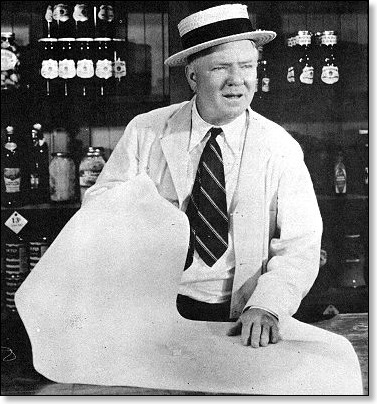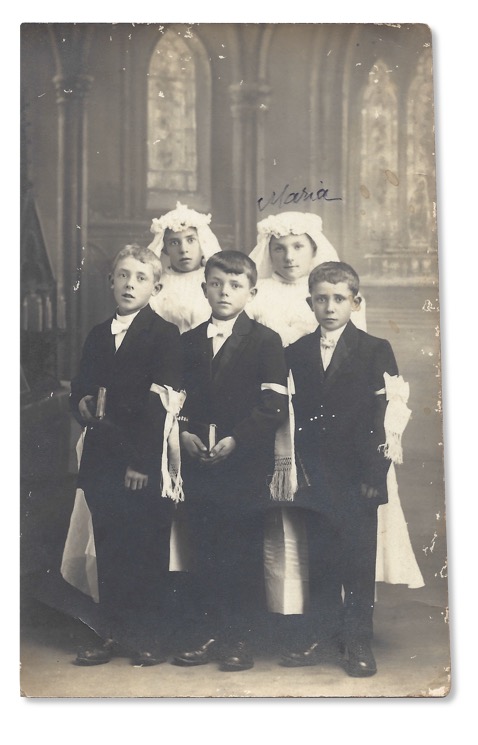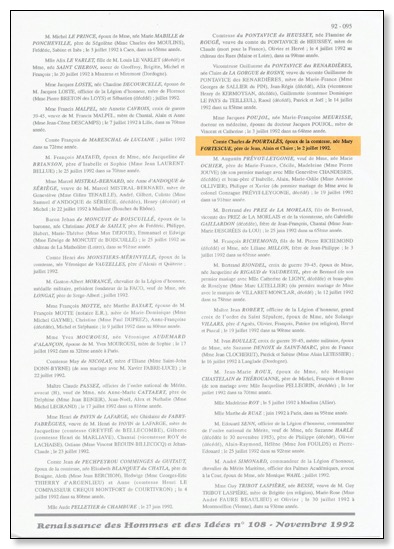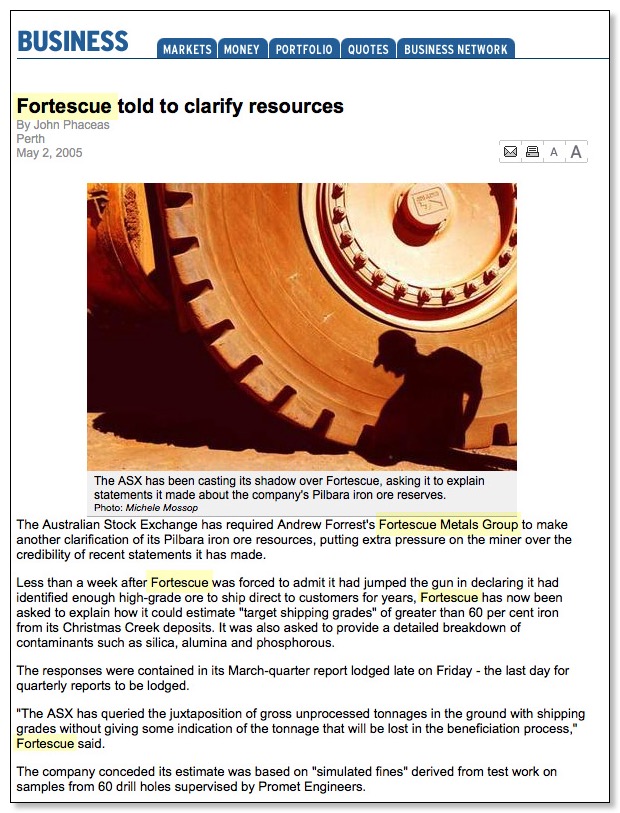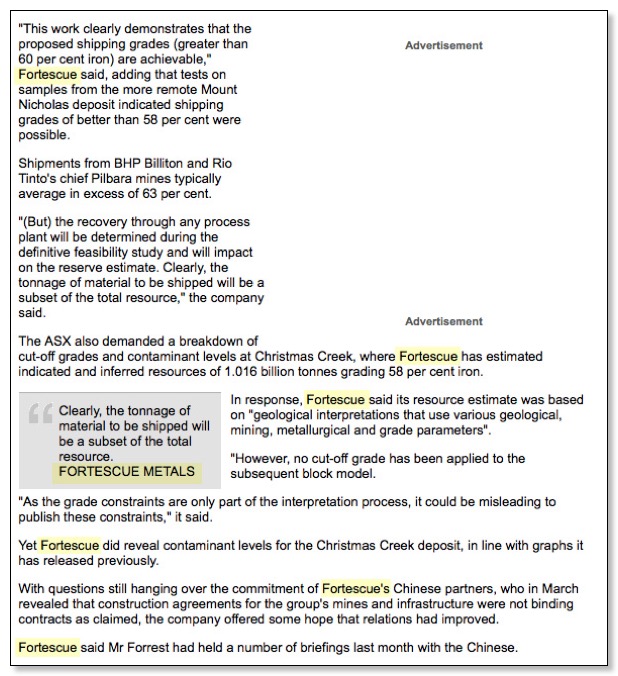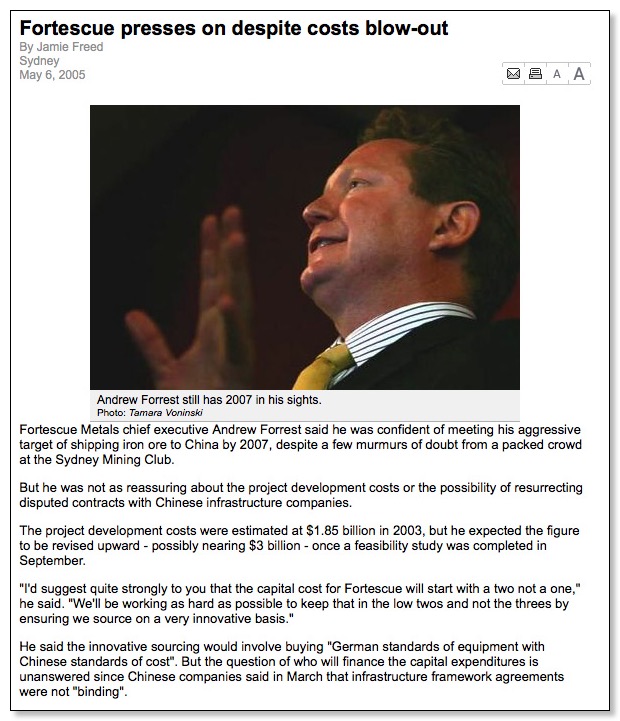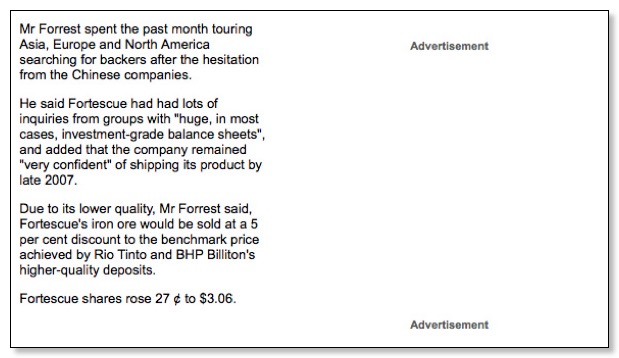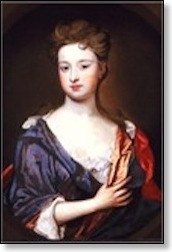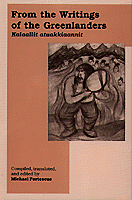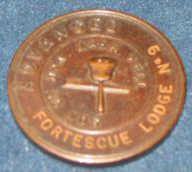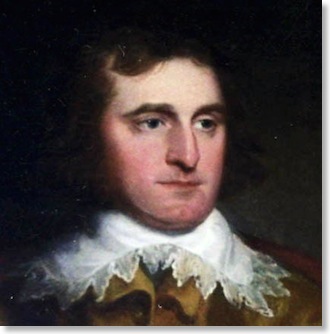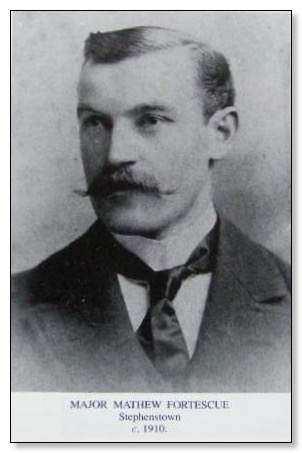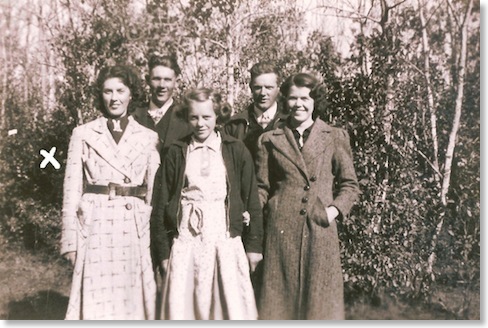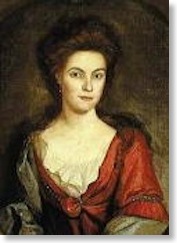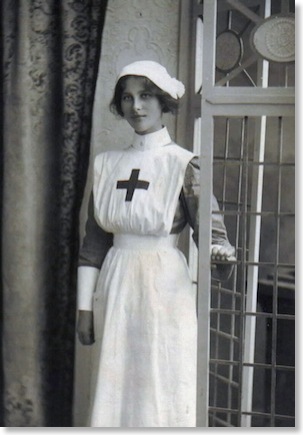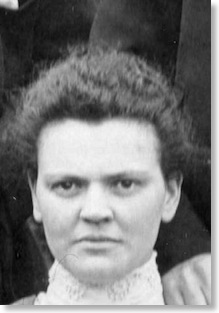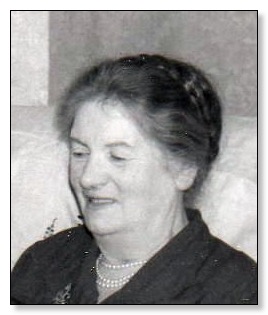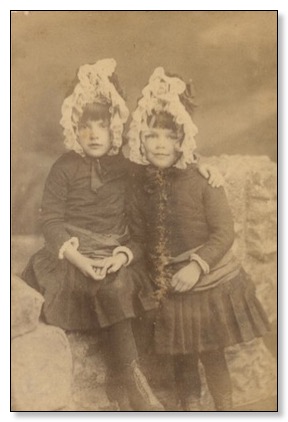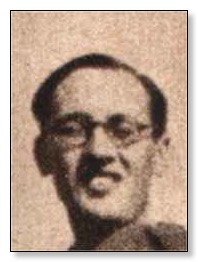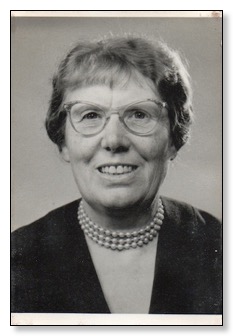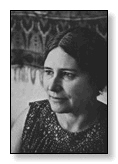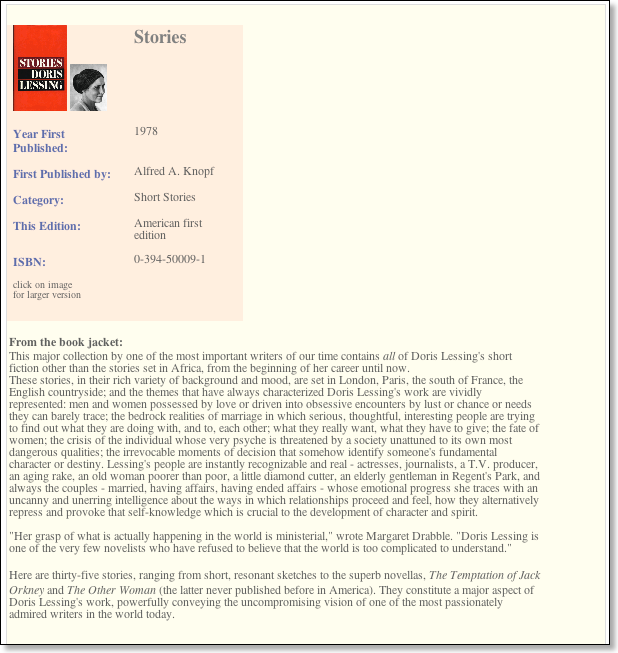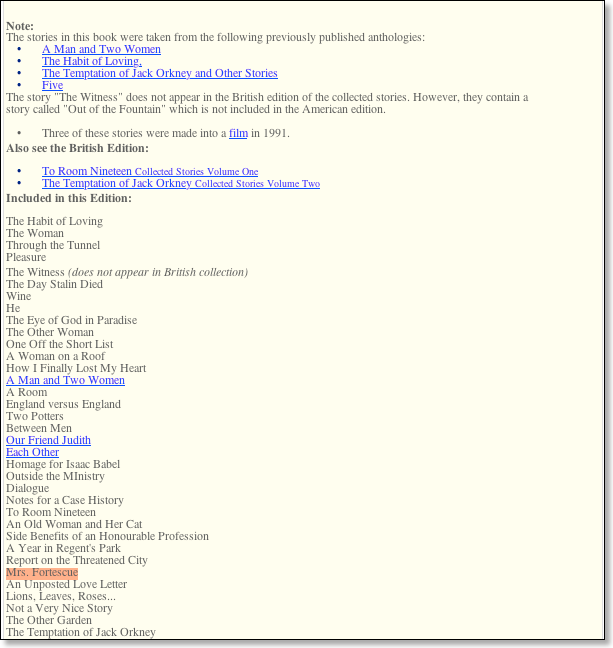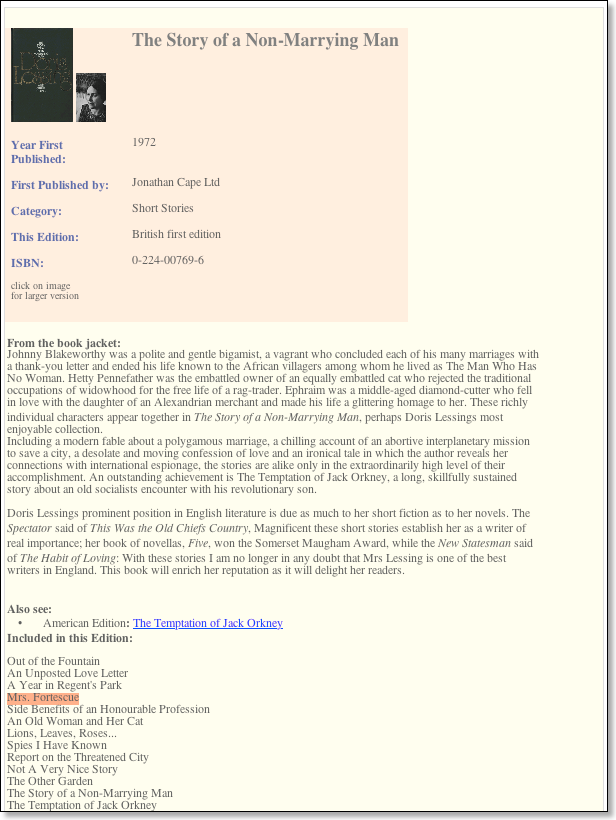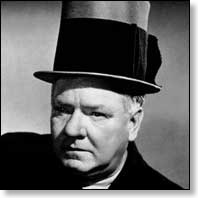Sommaire M
Monsieur ? Defortescu
«Le lendemain, vers cette heure-là...»
Le débarquement de juin 1944
vécu et raconté par une collégienne de Coutances
par Odile DANTON-BOUYSSOU
Télécharger en pdf
extrait :
...
Samedi 10 juin
Après un copieux petit-déjeuner, nous faisons la vaisselle, les lits, le
ménage. Le village de Saint-Jean est devenu trop dangereux ; aussi
décidons-nous de rester à la ferme. Les parents de Monsieur Leconte
refusent, quant à eux, de quitter leur maison, bien qu’elle soit située près
du carrefour, mais c’est leur maison – ils en sont les gardiens et ne veulent
pas « déserter ».
Comment nourrir tout ce monde ? Heureusement, il y a les poules, les
lapins, du lait, du beurre – pas de pain, mais les repas sont délicieux, bien
supérieurs à ceux que j’ai connus jusqu’ici. Le soir, nous préparons une
omelette quand arrive, dans une carriole tirée par un cheval, la soeur de
Madame Lefèvre, son mari, ses enfants – plus Ernestine, une voisine, et sa
bonne, plus Monsieur Defortescu, plus Madeleine Guesnon : tout le monde a
peur, car les Allemands se font plus menaçants. À plusieurs nous saurons
mieux nous défendre. Nous laissons notre lit « par terre » à la demi-douzaine
d’enfants. Les adultes sont sur les bancs, nous sur la table – vraiment peu
confortable ! À trois heures, nous ne dormons pas et prenons ce qui est
baptisé un « café », en fait de l’orge grillé et moulu. Les avions nous survolent
assez bas : impossible de fermer l’oeil ! Nous jouons aux petits carrés dans la
pénombre pendant que les adultes font semblant de dormir...
Minister
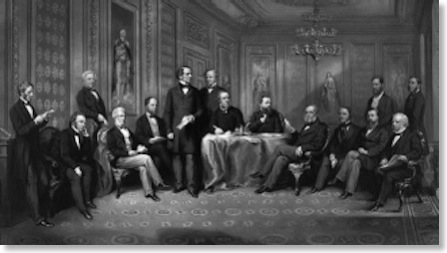
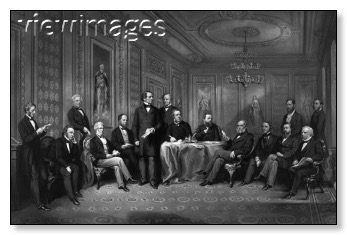
Filename: 809284_wm.jpg
Photographer:
Title: Gladstone's Ministry
Description:
British prime minister William Ewart Gladstone and his cabinet ministers, from left to right, Cardwell, Argyll, Lowe, Hatherley, Kimberley, Gladstone, Granville, Bruce, De Grey, Clarendon, Fortescue, Hartingden, Childers, Bright and Goschen.![]()
Fortescue Metal Group
Marianne fortescue
| SERVICE-LEARNING: jan99 by date |
By Charlie Knuth, Student Body Vice President
Published: Thursday, May 6, 2004
Updated: Sunday, September 6, 2009 10:09
....
Thank you for the hard work and dedication of the UNH Leadership Team: Kaelee Copley, Nicole Decocq, Alexis Berry, Adrienne Frazee, Meghan Walkaman, Lauren Skilling, Debbie Bryant, Cat Clarke, Mark LePine, Katie Sullivan, Marianne Fortescue, Holly Randall, and countless others. And thank you to everyone who participated and raised money for this wonderful cause!
more : http://www.tnhonline.com/2.3562/realy-for-life-is-a-big-success-1.396237
Relay for life returns to UNH
Coordinators hope to repeat last year's success
By Rebecca Lettoulier
Published: Tuesday, October 5, 2004
Updated: Sunday, September 6, 2009 10:09
....
"It was the single most unifying event that I have seen on this campus in the 25 years I've been here," said Marianne Fortescue on Tuesday, speaking of last year's Relay For Life held at UNH. The event committee held its first meeting in the MUB Tuesday, with its main focus this year being involving more students and student organizations.
....
more : http://www.tnhonline.com/2.3536/relay-for-life-returns-to-unh-1.395895
More more more : http://www.tnhonline.com/search-box-1.116558?q=fortescue

Matthew Fortescue
Mges 1860 from the NZ'er newspaper, Auckland
Author: Jacqueline Walles <jacwalles@clear.net.nz>
Date: 2000/10/06
Forum: soc.genealogy.australia+nz
MORESBY - GOLD
On 28th inst (sic) at St Stephens, Taurarua, by the Bishop of New Zealand,
Matthew Fortescue, eldest son of Vice Admiral Sir Fairfax Moresby, KCB, to
Caroline, third daughter of Major General Charles Emilius Gold. [NZ'er 1 Dec 1860]
Miss Fortescue Boat (Curiosité)
Higbee's Marina & Miss Fortescue
Serving ALL YOUR NEEDS
from breakfast and lunch, to bait and tackle,to launching your boat or allowing us to take you fishing. From spring maintenance to winterization.
Miss Fortescue
Captain Jim Higbee
(2000)
Open Boat:
Sails Daily - 7am-1pm
Afternoon trips:
Thurs, Fri, Sat - 4pm-10pm
Rates: $30.00 per person, rod rental: $5.00
53 ft. Fiberglass vessel with two 671 GM's,
the fastest on the Delaware Bay.
Captain Jim Higbee, a 3rd generation Captain, worked on the water most of his life. Has been the Captain of the Miss Fortescue for 17 years.
Amenities and Services include:
- Can hold up to 49 pasengers.
- Head for men and women
- Video Electronic Fish Finder
- Excellent Fish Cleaning Facilities Available on Dock
- Safety Equipment
- Congenial Crew
- Rod Rental $5.00
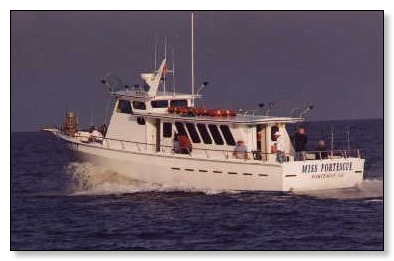

Michael Fortescue (Sciences)
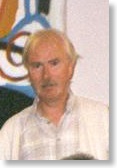
Research Centre for Linguistic Typology
http://search.latrobe.edu.au/search/index.cgi?query=fortescue&x=33&y=13&collection=Latrobe
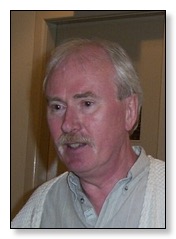
Distinguished Fellow Profile
Professor Michael Fortescue
Group Photo of 2001 Workshop Participants
From Left to Right:
Back Row:
Prof Randy LaPolla, Dr Tim Curnow, Connie Dickinson, Prof Ago Künnap, Dr Elena Maslova,
Prof. Lars Johanson, Prof Michael Fortescue, Dr Willem J. De Reuse, Dr Vjacheslav Chirikba
Middle Row:
Pilar Valenzuela, Prof. Brian Joseph, Prof. Sally McLendon, Prof. Victor Friedman
Front Row:
Ms Abby Chin, Prof Sasha Aikhenvald, Prof Bob Dixon
http://www.latrobe.edu.au/rclt/Workshops/2001/2001photopage.htm
The Department of General and Applied Linguistics
University of Copenhagen
Njalsgade 80, DK-2300 Copenhagen S, Denmark.
Phone: +45 353 286 40, Fax: +45 353 286 35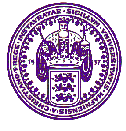
IAAS -- Institut for Almen og Anvendt Sprogvidenskab -- IAAS
Michael Fortescue
Email: mf@cphling.dk
Office: 5.1.15
Direct Phone: (+45) 353 286 67
Department of Eskimology
University of Copenhagen
Strandgade 100H
1401 Copenhagen K
Denmark
Present research:
Preparation of the 2nd edition of the Comparative Eskimo Dictionary
Since the appearance of the first edition of the Comparative Eskimo Dictionary (see 1994b above), much new lexical material has come to light that needs to be integrated into the projected second edition of this large dictionary (1st edition: 630pp.). This includes new data on 'Naukanski' Yupik from the Asian side of Bering Strait, gathered from informants and field workers by the co-editors at Alaska Native Language Center, University of Alaska, Fairbanks, which is currently being organized into an independent dictionary of that lexically poorly represented variety of 'Siberian' Eskimo.
From Canada there is new data from Arctic Quebec (partly based on the native Inuktitut-Inuktitut dictionary of Taamusi Qumaq), and material for a comprehensive dictionary of the western Canadian dialects by Duncan Pryde. This was left in the hands of the Institute of Eskimology after the author's recent death specifically for the purpose of integrating the hitherto unpublished data there into the CED (there was only limited access to part of it for the first edition). It is in the form of several thousand library cards with hand-written - but reliable - entries for a wide range of Canadian Inuit dialects and sub-dialects. This is a particularly welcome addition, since the western Canadian dialects have been relatively under-documented until recently and since they are much more conservative than the easterly Inuit dialects they are important for the comparative endeavour: individual forms from Pryde's material have confirmed a number of suspected cognates and caused the reformulation of others. There is also new East Greenlandic data to be integrated.
Besides filling the lacunae in the dictionary for these languages/dialects, there are numerous adjustments, additions and corrections to the dictionary that need to be made at this point (including the expansion of the indexes). In the process nearly two hundred new proto-Eskimo (or proto-Inuit or proto-Yupik) cognate sets have already been unearthed or separated out. The wide range of semantic change from Proto-Eskimo to the modern dialects is also intended as a resource for the general study of language change and is not only aimed at specialists. The format is devised to make reference easy also for 'ordinary' speakers of these languages interested in the historical sources of the words they use. In principle the dictionary can be used to check the etymology of - for example - any modern West Greenlandic word that is also found in the related languages of North America; with the new additions the coverage and detail will be significantly enhanced.
| | |
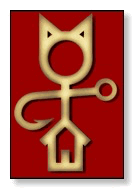
eskimo words for snow derby
From: sderby@crick.ssctr.bcm.tmc.edu (Stuart P. Derby)
Newsgroups: alt.folklore.urban
Subject: Eskimo words for Snow
Date: 2 Nov 1994 22:54:58 GMT
Discussion
Does "Eskimo" REALLY have some megaboss number of words for snow? Well that depends on what "megaboss" means, of course. And it also depends on what language you decide is "Eskimo". The dialects spoken by coastal native peoples from the east of Siberia to Greenland are classed as Eskimo, but many scholars divide them into two languages, Yupik and Inuit, with some scholars further sub-dividing these dialects. Inuit (also called Inupik) is the best candidate from a folkloric point of view, being spoken most widely, from Greenland to northeastern Alaska, having been written earlier (1742), having about twice as many speakers, and having had longer and greater contact with "Western Civilization". (Greenlandic Inuit contains 4 words borrowed from medieval Norse.[1])
Another complication to the issue is simply the notion of "word". Languages vary quite drastically in how the base units of meaning (morphemes) are combined into words, if they're combined at all, and our common notion of "word" needs clarifying. For example, in English, are "book" and "books" two SEPARATE words? I would guess that most of us would think not. (What about "book", "handbook", "guidebook", "workbook"?) However, many languages are "isolating", wherein one word corresponds to one element of the situation, and would use two separate words to say "books". A speaker of such a language might well regard "book" and "books" as two separate words. The Eskimo languages are at the other extreme, and are the prototypical example of a polysynthetic language[2], wherein one word contains several elements of the situation. This allows very complex ideas to be expressed in one word, e.g. 'tikitqaarminaitnigaa' "he(1) said that he(2) would not be able to arrive first"[1].
Thus "my snow", "your snow", etc., would each be one word in Inuit, a stem form with a possessive affix. The Eskimo languages use derived words extensively, and there are fewer than 2,000 base stems in the West Greenlandic dialect[1] With all that said, I'll just present some word lists and let everyone come up with their own opinion...
10 words for ice and snow from Labradoran Inuit[3]
This word list is extracted from an Eskimo to English "dictionary" and is definitely not comprehensive. This was the worst such compilation I have ever worked with; among other problems, the compilers' attempts to alphabetize things, even short indices, failed miserably (e.g. "snow" before "seasons"). Consider also this from the preface:
Be it noticed beforehand that the Eskimo are not agreed in the use of their language with reference to many words -- not only that in the South here and there other expressions are used, and also that to many a word another meaning is given than in the North, but even in one and the same place not infrequently such differences are found. And frequently the female sex has again its peculiar expressions. With regard to the latter, not much notice has been taken in composing this dictionary, because the men often only laugh about them; ...
- 'ice' sikko
- 'bare ice' tingenek
- 'snow (in general)' aput
- 'snow (like salt)' pukak
- 'soft deep snow' mauja
- 'snowdrift' tipvigut
- 'soft snow' massak
- 'watery snow' mangokpok
- 'snow filled with water' massalerauvok
- 'soft snow' akkilokipok
This word list is taken from a book on West Greenlandic grammar is almost certainly not comprehensive. I've entered the list as it appears in Fortescue's "West Greenlandic". Note that in Fortescue 'q' corresponds to 'k' in Peck.
- 'sea-ice' siku (in plural = drift ice)
- 'pack-ice/large expanses of ice in motion' sikursuit, pl. (compacted drift ice/ice field = sikut iqimaniri)
- 'new ice' sikuliaq/sikurlaaq (solid ice cover = nutaaq.)
- 'thin ice' sikuaq (in plural = thin ice floes)
- 'rotten (melting) ice floe' sikurluk
- 'iceberg' iluliaq (ilulisap itsirnga = part of iceberg below waterline)
- '(piece of) fresh-water ice' nilak
- 'lumps of ice stranded on the beach' issinnirit, pl.
- 'glacier' (also ice forming on objects) sirmiq (sirmirsuaq = Inland Ice)
- 'snow blown in (e.g. doorway)' sullarniq
- 'rime/hoar-frost' qaqurnak/kanirniq/kaniq
- 'frost (on inner surface of e.g. window)' iluq
- 'icy mist' pujurak/pujuq kanirnartuq
- 'hail' nataqqurnat
- 'snow (on ground)' aput (aput sisurtuq = avalanche)
- 'slush (on ground)' aput masannartuq
- 'snow in air/falling' qaniit (qanik = snowflake)
- 'air thick with snow' nittaalaq (nittaallat, pl. = snowflakes; nittaalaq nalliuttiqattaartuq = flurries)
- 'hard grains of snow' nittaalaaqqat, pl.
- 'feathery clumps of falling snow' qanipalaat
- 'new fallen snow' apirlaat
- 'snow crust' pukak
- 'snowy weather' qannirsuq/nittaatsuq
- 'snowstorm' pirsuq/pirsirsursuaq
- 'large ice floe' iluitsuq
- 'snowdrift' apusiniq
- 'ice floe' puttaaq
- 'hummocked ice/pressure ridges in pack ice' maniillat/ingunirit, pl.
- 'drifting lump of ice' kassuq (dirty lump of glacier-calved ice = anarluk)
- 'ice-foot (left adhering to shore)' qaannuq
- 'icicle' kusugaq
- 'opening in sea ice imarnirsaq/ammaniq (open water amidst ice = imaviaq)
- 'lead (navigable fissure) in sea ice' quppaq
- 'rotten snow/slush on sea' qinuq
- 'wet snow falling' imalik
- 'rotten ice with streams forming' aakkarniq
- 'snow patch (on mountain, etc.)' aputitaq
- 'wet snow on top of ice' putsinniq/puvvinniq
- 'smooth stretch of ice' manirak (stretch of snow-free ice = quasaliaq)
- 'lump of old ice frozen into new ice' tuaq
- 'new ice formed in crack in old ice' nutarniq
- 'bits of floating' naggutit, pl.
- 'hard snow' mangiggal/mangikaajaaq
- 'small ice floe (not large enough to stand on)' masaaraq
- 'ice swelling over partially frozen river, etc. from water seeping up to the surface' siirsinniq
- 'piled-up ice-floes frozen together' tiggunnirit
- 'mountain peak sticking up through inland ice' nunataq
- 'calved ice (from end of glacier)' uukkarnit
- 'edge of the (sea) ice' sinaaq
Does Eskimo have some megaboss number of words for snow? It depends on how you count, but they certainly have more than English.
Some miscellany.
While English "igloo" meaning 'snow house' comes from Inuit, "iglo" (or "illu") more generally means 'house' or home' in most dialects. Sometimes houses are constructed of peat[3,4]. English "kayak" comes from Intuit "qayaq" (means the same)[3,4]. The stereotypical Eskimo name Nanook corresponds to "nanuq" 'polar bear'[4].
Scholars sure do have understated ways of sniping at each other: "In fact Bourquin's tendency to describe the Labrador dialect by quoting at length from Kleinschmidt's description of Greenlandic is unavoidably a major methodological impediment for present-day researchers.[5]"
References
[1] Encyc. Britannica,15th Ed.,1984, ISBN 0-85229-413-1.
Macropaedia Vol. 6, p962-964, "Eskimo-Aleut Languages". [2] Historical Linguistics: An Introduction, 1973, Winfred P. Lehman,
ISBN 0-03-078370-4.p46-49 [3] Eskimo-English Dictionary: Compiled from Erdman's Eskimo-German
Edition of 1864, 1925, Rev. Edmund J. Peck, D.D. (C.M.S. Missionary, Apostle to the Eskimos). We don't need no stinkin' ISBN! [4] West Greenlandic,1984, Michael Fortescue. ISBN 0-7099-1069-X [5] Eskimo Languages: Their Present Day Conditions, 1979,
Basse&Jensen, eds., p.94.
Stu "just the faqs, ma'am" Derby
Etudes Inuit Studies
| | |
| Etudes Inuit Studies |

| | |
Etudes Inuit Studies | |
| | Thule and Back: A Critical Appraisal of Knud Rasmussen's Contribution to Eskimo Language Studies |
Etudes Inuit Studies | |
| | |
| The historical source and typological position of ergativity in Eskimo languages | |
Etudes Inuit Studies | |
Art, Music, Languages |
| |
Michael Fortescue | (red):
From the Writings of the Greenlanders
| This prose sampler from West Greenland reveals a century-old independent literary tradition, the rich written expression of an ancient and succesful culture. Linguist Michael Fortescue compiled these excerpts to demonstrate the range of Greenlandic writing and make works in this flourishing language more accessible to English speaking readers. In English and Greenlandic language. |
245 pages. 178,00 Dkr. |
| | |
LINGUIST List 3.743 | |
| Message 2: E-Mail Addresses | Date: Tue, 29 Sep 92 10:26:39 BSE-Mail Addresses |
| | |
LINGUIST List 2.648 | |
| Message 3: Re: 2.645 Pronouns | Date: Fri, 11 Oct 91 18:46:59 -0700 |
| | |
LINGUIST List 9.1600 | |
| BOOK REVIEWS Comparative Eskimo Dictionary with Aleut Cognates ( | Michael Fortescue, Steven Jacobson, and Lawrence Kaplan, editors), JONATHAN DAVID BOBALJIK |
| | |
LINGUIST List 9.677 | |
| Message 4: Inuktitut Spatial Terms | |
| | |
LINGUIST List 6.1506 | |
| Message 1: Sum (2): Historical Data Sets | Date: Thu, 26 Oct 1995 16:22:25 Sum (2): Historical Data Sets |
| ... New References: | Fortescue, Michael D. et al. 1994. _Comparative Eskimo Dictionary: with Aleut cognates_. Alaska Native Language Center, U of Alaska, Fairbanks. ISBN: 1555000517. LCCN: 94-024177. (I know nothing of the contents of this book, except that there are purported to be Eskimo cognate lists in dictionary format.) |
| | |
LINGUIST List 4.636 | |
| Message 1: Summary: Coordination of null pronominal | Date: Fri, 20 Aug 93 14:43:03 -0Summary: Coordination of null pronominal |
| | |
LINGUIST List 4.1041 | |
| Message 1: Acquisition of native languages of Canada. | Date: Sun, 5 Dec 93 15:20:20 ESTAcquisition of native lgs. |
| 8. Fortescue, Michael & Lise Lennert Olsen. 1992. The acquisition of West Greenlandic. In: D. I. Slobin (ed.), The Crosslinguistic Study of Language Acquisition. Volume 3. Hillsdale, NJ: Lawrence Erlbaum Associates. Pp.111-219. 9. | Fortescue , Michael . Learning to speak Greenlandic: a case study of a two-year-old's morlogy in a polysynthetic language", in First Language 5, 101-114. |
| | |
| | |
| | |
| | |
www.mis.coventry.ac.uk |
Martin Fortescue (Sciences)
Dr Martin Fortescue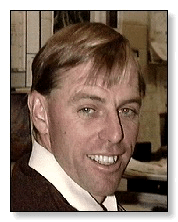
B.App.Sc. M.App.Sc. PhD [UC]
Current Position: Operations Manager, Booderee National Park.
Thesis Topic: Oceanographic change and breeding success of the Little Penguin on Bowen Island, Jervis Bay.
Research Interests: Endangered species (small mammals), rehabilitation of debilitated aeas, weed management and control.
Contact:
Tel: 044 421034 [International: +61 6 044 421034]
Fax: 044 421063 [International: +61 6 044 421063]
Email: fortescue@aerg.canberra.edu.au
www: http://aerg.canberra.edu.au/pub/aerg/staff/stuforte.htm
Postal Address:
Booderee National Park,
Village Road, Jervis Bay,
NSW 2540, Australia
(aerg.canberra.edu.au)
Applied Ecology Research Group
Research Interest
Endangered species (small mammals), rehabilitation of debilitated aeas, weed management and control.
Thesis Topic
The Effect of Oceanographic Change on the Breeding Success of the Little Penguin on Bowen Island, Jervis Bay.
Qualifications
M.App.Sc. (1991) Applied Ecology Research Group, University of Canberra
Current Positions
PhD Candidate, Applied Ecology Research Group, University of Canberra
Contact
Jervis Bay National Park
Australian Nature Conservation Agency
Village Road
JERVIS BAY NSW 2540
Phone National: 044 421034; International: +61 6 044 421034
Fax National: 044 421063; International: +61 6 044 421063
Conservation Biology & Native Species Research
Applied Ecology Research Group
Conservation Biology & Native Species Research
Background
Interest in protecting native plant and animal species has intensified in the last few decades. Both scientists and the general public have realized that the threats to wildlife have increased, with many species facing the possibility of extinction. Conservation biology, which was developed to deal with these issues, requires an interdisciplinary approach. We need to study ecology, to know how the species interacts with its environment so that key elements of its environment can be protected or manipulated to ensure the species survival. We need to know something of the demographic processes leading to extinction, so that those processes and the factors influencing them can be manipulated to stem or reverse a species' decline. If species are to be conserved in the context in which they evolved, so that they have the potential to persist in the long term and to continue to evolve and speciate, then we need to learn something of their population genetics.
Relevant information must be presented in a useful form to those in a position to decide policy and direct resources. Managers seeking to achieve conservation objectives must weigh the advantages of conserving a species against the competing interests seeking to exploit the species or its habitat. Research undertaken by the Applied Ecology Research Centre is designed to provide increased understanding of species biology, especially where this is relevant to conservation, and to provide this information in a form readily usable by agencies with a responsibility for species conservation.
Of a lower priority, but perhaps equally important in the longer term, is research directed at fundamental understanding of the biology of the Australian biota, whether or not they are in decline. As an island continent, Australia has a flora and fauna characterised by a high level of endemism. The fourteen families of marsupials are found in Australia and New Guinea, but nowhere else. We have the platypus and echidnas, the lyrebirds and scrub-birds, a spectacular radiation among the kingfishers, the pygopodid lizards, a snake fauna dominated by the elapidae, the pig-nosed turtle, two major radiations of frogs and a high level of endemicity among our freshwater fishes. Similar and equally striking examples could be provided from the flora.
The Gondwanal origins of the Australian continent also have had a profound influence on the composition of the flora and fauna. From a northern hemisphere perspective, the Australian biota is unusual indeed.
Long-standing isolation, Gondwanal origins and a dry and highly variable climate pervading much of the continent, provide many opportunities for studying evolution and ecology, opportunities that are unavailable to biologists on other continents.
The major thrust of many of the projects in this programme is to conduct research on the ecology, evolution and systematics of native species and so contribute to fundamental knowledge of the Australian fauna and flora and to theoretical frameworks which underpin our understanding of animal and plant biology.
Projects
Many projects conducted by staff and postgraduates of the Applied Ecology Research Group are centred on species or issues of conservation priority or management relevance. They include studies of recently established populations of the small macropod Bettongia pennicillata, conservation biology of the endangered pink-tailed legless lizard Aprasia parapulchella, population genetics of insular lizards following recent and not so recent habitat fragmentation, ecology and management of penguins at Jervis Bay, distribution and ecology of the rare pig-nosed turtle, ecology and management of Australian birds of prey, and the conservation of declining amphibian populations in the Australian Alps.
Projects of less immediate relevance to conservation but important nevertheless because of their contribution to fundamental understanding of the biology of the Australian biota include studies of the effect of Aboriginal harvests on reproductive parameters of magpie geese, ecology of Australian birds of prey, comparative diets of tree-rats in the Kimberlies, patterns and processes of regeneration in butterbush, biochemical systematics and evolution of Australian turtles, identification of cryptic species of frogs of the Alps and reptiles, ant-lizard relationships, and temperature-dependent sex determination in reptiles.
Profile
The research progam has a national profile through its links to priority areas identified by the Commonwealth and State governments and funded through their agencies. For example, research is or has been funded through the
Endangered Species Progam of the Australian Nature Conservation Agency;
parks and conservation agencies of the ACT, New South Wales, the Northern Territory, Victoria and Queensland;
Australian Alps National Parks Liaison Committee;
ACT Planning Authority;
ACT Electricity and Water.
Through this research, the Group has built up a national reputation for conducting targeted conservation-related research in its particular areas of expertise, and is now regularly approached directly by agencies to take a leading role in such research.
Progam Leader
Dr Will Osborne, [Reptiles and Amphibians]
Other Research Staff
Dr Arthur Georges, [Wildlife Biology]
Dr David Williams, [Vegetation Ecology]
Mr Gerry Olsen, [Raptor Biology]
Dr Anne Kerle (Alice Springs), [Small Mammals]
Dr Ken Green (Kosciusko), [Small Mammals]
Dr John Harris, [Environmental Education]
Dr John Dearn, [Population Genetics]
Dr Jim Hone, [Wildlife Management]
Visiting Research Fellows
Prof. Terry Graham, (1994,96) [Turtle Biologist]
Prof. Brad Shaffer, (1995,96) [Molecular Biologist and Herpetologist]
Dr Rod Kennett, (1996) [Wildlife Biologist]
Current Postgraduate Students
Kerry Beggs, [Honours, TSD in field nests of Carettochelys]
Sean Doody, [PhD, TSD in field nests of Carettochelys]
Virginia Ebsworth, [Honours, penguin ecology]
Lisa Evans, [PhD, riparian vegetation dynamics]
Martin Fortescue, [PhD, penguin ecology]
Jeff Foulkes, [PhD, brushtail possums]
Enzo Guarino, [Honours, water dragons]
David Hunter, [Masters, corroboree frogs]
Sandra ones, [PhD, legless lizards]
David Judge, [Masters, the Sydney tortoise]
Michael Smith, [Honours, ###]
Scott Thomson, [Masters, chelid morphology and systematics]
Paul Wallace, [Masters, ###]
Former Postgraduate Students
Sarah Broomhall, [Honours, frog declines]
Simon Holloway, [Masters, Gippsland Frogs]
Robert Jansens, [Honours, earless dragons]
Mutjindi Katjiua, [Masters, trees and native pasture]
Art Langston, [Honours, earless dragons]
Neil McElhinney, [Masters, Green and Gold Bellfrogs]
Tony Richards, [Honours, Phragmites ecology]
Wayne Robinson, [Masters, ant-lizard relationships]
Michelle Walters, [Honours, pigmy possum]
Donna Nunan,[Honours, legless lizards]
Sharon Kilgour [Honours, terrestrial migration in freshwater turtles]
Suzanna Podrika [Honours, environmental contaminants and sex determination in reptiles]
Soma Trenggana, [Masters, Indonesian rhino] Fiona Beynon [Honours, oxygen consumption in turtle eggs]
Michaela Sraml [Masters, waterfowl systematics]
Sandra Jones, [Honours, legless lizards]
Nick Dexter [Masters, Aboriginal harvests of Magpie Geese]
Martin Fortescue [Masters, Penguin breeding biology]
Civa Morton [Honours, diet of tree rats]
Flywell Munyenyembe [Masters, urban bird distribution]
Wayne Murray, [Masters, koalas]
Lyn Nelson, [Masters, woylies]
Stephen Sarre, [Masters, insular lizards]
Doug Wahl, [Masters, flying foxes]
Selected Publications
DEXTER, N. and BAYLISS, P. (1991). The effect of experimental clutch harvest on numbers of magpie goose nests and juvenile recruitment. Wildlife Research 18:533-538.
GEORGES, A. (1989). Female turtles from hot nests: Is it amount of development or duration of incubation at high temperatures that matters? Oecologia, Berlin 81:323-329.
GEORGES, A. and ADAMS, M. (1992). A phylogeny for the Australian chelid turtles based on allozyme electrophoresis. Australian Journal of Zoology 40:453-476.
GEORGES, A. (1994). Setting conservation priorities for Australian freshwater turtles. Pp: 49-58 in Lunney, D. and Ayers, D. (eds). Herpetology in Australia -- A Diverse Discipline. Trans. Roy. Soc. NSW Surrey Beatty ad Sons, Chipping North.
GEORGES, A., STOUTJESDIJK, R. and LIMPUS, C.J. (1994). Hatchling sex in the marine turtle Caretta caretta is determined by proportion of development at a temperature not daily duration of exposure. Journal of Experimental Zoology 270:432-444.
KENNETT, R., GEORGES, A. and PALMER-ALLEN, M. (1993). Early developmental arrest during immersion of eggs of a tropical freshwater turtle, Chelodina rugosa (Testudinata: Chelidae), from northern Australia. Australian Journal of Zoology 41:37-45.
GEORGES, A. and ADAMS, M. (1996). Electrophoretic delineation of species boundaries for the short-necked chelid turtles of Australia. Zoological Journal of the Linnean Society, London. In press.
MUNYENYEMBE, F.E., HARRIS, J.A., NIX, H. and HONE, J. (1989). Determinants of bird distribution and abundance in suburban Canberra, Australia. Australian Journal of Ecology 14:549-557.
OSBORNE, W.S. (1989). Distribution, relative abundance and conservation status of the corroboree frog Pseudophryne corroboree Moore (Anura: Myobatrachidae). Australian Wildlife Research 16:537-547.
OSBORNE, W.S. and NORMAN, J.H. (1991). Conservation genetics of corroboree frogs, Pseudophryne corroboree Moore (Anura: Myobatrachidae): population subdivision and divergence. Australian Journal of Zoology 39:285-297.
SARRE, S. and DEARN, J.M. (1991). Morphological variation and fluctuating asymmetry among insular populations of the sleepy lizard Trachydosaurus rugosus (Squamata: Scincidae). Australian Journal of Zoology 39:91-104.
SARRE, S., DEARN, J.M. and GEORGES, A. (1994). The application of fluctuating asymmetry in the monitoring of wildlife populations. Pacific Conservation Biology 1:118-122.
Applied Ecology Research Group
Unrefereed Journal Articles
DEARN, J.M. (1992). Maintaining the quality of first year science teaching. Research and Development in Higher Education 15:367-374.
FORTESCUE, M.E. (1992). Little Penguins and seagrass meadows. Australian Ranger Bulletin, Autumn 1992.
GEORGES, A., CHOQUENOT, D., COVENTRY, A.J. and WELLINGS, P. (1989) A note on Carettochelys insculpta (Testudinata: Carettochelydidae) from northern Australia. Northern Territory Naturalist 11:8-11.
GILLESPIE, G.R. and OSBORNE, W.S. (1994). Update on the status of the spotted tree frog (Litoria spenceri) in the Australian Capital Territory. The Victorian Naturalist 111:182-183.
HARRIS, J.A.and DEARN, J.M. (1990). The challenge of teaching ecology. New Education 12:97-107.
HONE, J. and STONE, C. (1989). A comparison and evaluation of feral pig management in two national parks. Wildlife Society Bulletin17:419-425.
JONES, S.R. (1993). Pink-tailed legless lizards: One of Canberra's own. Bogong 14(3):9.
KENNETT, R. and GEORGES, A. (1989). Turtles of the Top End. Northern Territory Naturalist 11:31.
KRISTO, F. and FORTESCUE, M.E. (1991). At home with penguins. Birds International 2(1):50-58.
OLSEN, J. (1990). Further thoughts on risk of accident and reversed sexual dimorphism in raptors. Australasian Raptor Association News 11:30-31.
OLSEN, P. and OLSEN, J. (1990). Australian raptors. Eyas 13:22-24.
OLSEN, P., MALLINSON, D. and OLSEN, J. (1990). The bird community of Mg Mugga, ACT: June 1982 to January 1986. Australian Bird Watcher 14:13-23.
OLSEN, P.D. and OLSEN, J. (1989). Australia's Brown Falcon. Birds International 11(2):68-72.
OSBORNE, W.S. (1990). Declining frog populations and extinctions in the Canberra region. Bogong 11:4-7.
OSBORNE, W.S. (1992). Rare and endangered: The corroboree frog. Australian Natural History 1992:16-17.
OSBORNE, W.S., KUKOLIC, K., DAVIS, M.S. and BLACKBURN, R. (1993). Recent records of the earless dragon Typanocryptis lineata pinguicolla in the Canberra region and a description of its habitat. Herpetofauna 23:16-25.
OSBORNE, W.S., GILLESPIE, G.R. and KUKOLIC, K. (1994). The spotted tree frog Litoria spenceri: an addition to the amphibian fauna of the Australian Capital Territory. Victorian Naturalist 111:60-64.
ROSS, T., OLSEN, P., OLSEN, J. and METCALFE, R. (1989). Incubation period of the collared sparrowhawk. Australian Bird Watcher 13:59-61.
Fortescue Mann Publisher (Sciences)
SV by Fortescue Mann Publisher Advertising on back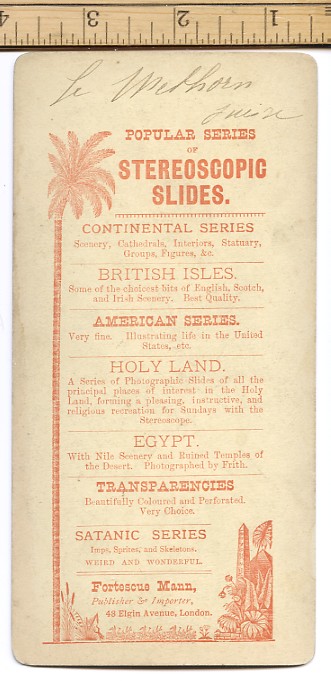
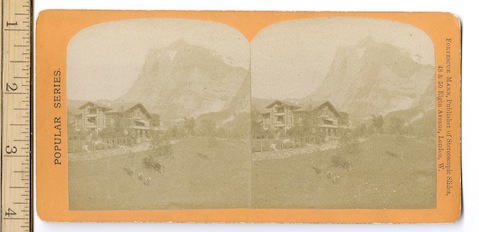
Real photo stereoview card. Text on front sides reads: "Forteskue Mann Publisher of Stereoscopic Slides, 48 & 50 Elgin Avenue, London, W.
Popular Series.
Advertising is printed on back side.
Stereoview is a bit faded.
Good condition with a few spots.
See scanned front & back.
Fortescue Magnetite (Sciences)
| | Fortescue magnetite deposits | |
| | ||
![]()
| | |
| | Iron Ore Processing | Fortescue (Cape Preston) - Integrated Steel Plant |

Moulinet (Curiosité)
ANCIEN MOULINET
OCEAN CITY, FORTESCUE, Lake City
des années 30/40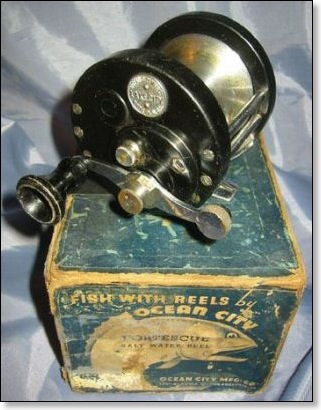
This auction is for a Fortescue free spool casting reel.
It came from an estate sale, I think it is quite old. It is marked “FORTESCUE – FREE SPOOL – OCEAN CITY MFG. CO. – PHILA.”.
It appears to be in good working order but does need to be cleaned, being sold as found. The wood knob on the crank handle has white paint spilled on it. It is marked 250 on the base plate. On the side opposite the crank there are the remnants of a label that has numbers and colors; there also is the remnant of some other material, not sure if it is original or something that was added.
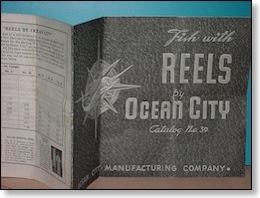
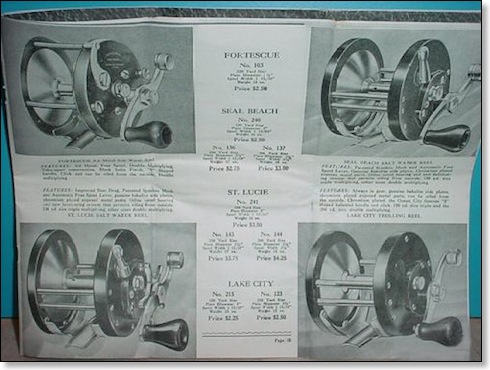

Muriel Fortescue (Mabel Normand)
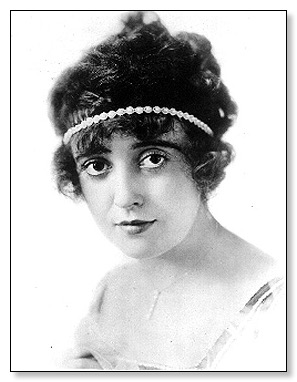
Mabel Normand:
The Beautiful Knockabout
A Silents Majority Featured Star
Born November 9, 1892, on Staten Island, NY
Died February 23, 1930, in Monrovia, CA
Mabel Normand was a contemporary of Mary Pickford, the Gish sisters (Lillian and Dorothy), Blanche Sweet, Florence Lawrence and the Talmadge sisters (Norma and Constance). She made her film debut in either The Indiscretions of Betty (Vitagraph, 1910) or Over the Garden Wall (Vitagraph, 1910) as a serious, dramatic actress (it is unclear which film was first). Before that, Mabel was already popular as a model for fashions and illustrations. Throughout parts of 1910 and 1911, Mabel worked for the Vitagraph studio. By the end of 1911, she had moved on to American Biograph under the direction of D.W. Griffith. She worked very hard to hone her craft by cranking out a number of melodramas, one of which, The Mender of Nets (1912), starred Mary Pickford. Fortunately, Mabel was proud of the Normand name and was determined to keep it. If she hadn't been, she may have become known to her fans as "Muriel Fortesque," the generic marquee name assigned to her to enforce the anonymity that was required of early screen performers. Mabel Normand never could and never would remain anonymous.
Mabel was strikingly beautiful, but that wasn't unusual for actresses. During this early period in their careers, Mary, Lillian, Dorothy and the rest were considered heartbreakingly beautiful. What made Mabel different is that, when she fell down, she was as funny as she was fetching. It didn't take long for Griffith to realize that Mabel had great comic talent, and he started assigning her to comical plots. Griffith, a drama director, employed a young actor-turned-director named Mack Sennett to guide Mabel's comic hijinks. [Sennett's movie-making career, like those of many of the Greats, began with Griffith. His intense desire to learn at the feet of the master and fully realize his ambitions, catapulted him up the ladder to the director's chair at Biograph.]
Mabel took her first shot at comedy in The Diving Girl (Biograph, 1911), in a charming and memorable role as a funny (and not a little sexy) bathing beauty. As men remember the first time they saw Marilyn Monroe in a bathing suit, the men and boys of the early 1910s never forget the first time the adorable Mabel donned a bathing costume. So, historically, the first Sennett bathing beauty was our Beautiful Knockabout, Mabel. (Master director King Vidor saw Mabel in that clinging suit when he was a young pup in Galveston, Texas - and claims that her image stayed with him and initially spurred his dream to make movies.)
What? A beautiful slapstick comedienne? Audiences were used to seeing screen comediennes who looked as funny as their antics. These included such funny girls as Flora Finch, who was built like a bean pole; Louise Fazenda, a kooky clown with the fashion sense of a country bumpkin; Polly Moran, a wild-haired, man-chasing harridan; and Marie Dressler, hefty and hilarious, but who declared, "I born without a pretty face, and thank the Lord I do not have to live up to such a burden." Beautiful Mabel could take a hearty pratfall with the best of the Keystone Kops, but one could also fall in love with her as a custard pie was thrust into that angelic face. Like a gambler with a sure bet, Mack could see that his future with Mabel was in the cards.
As vivacious and charismatic as Mabel was, one can't think of her without thinking of Mack. As soon as he spotted her captivating beauty adorned with her comic gifts (and it didn't take long), he turned on the old Sennett charm and skillfully won her over - plucking her heartstrings in the process. By September 1912, most of her films were being directed by Sennett, still at the eastern Biograph studio. Between February and September, that same year, the two cranked out no less than 22 one- and two-reelers. Then, in late September, Mack took his comic protégée (and by now the love of his life) out West and formed his own studio in Hollywood - Keystone.
Our knockout-knockabout made dozens of bright and lively farces in the Sennett style at Keystone between 1912 and 1916 with early Keystone stalwarts like Fred Mace, Hank Mann, Ford Sterling, Al St. John, Harry Gribbon, Mack Swain, Roscoe Arbuckle, Charlie Chaplin, Minta Durfee (one of her closest friends) and Luke the dog. However, Mabel wanted more. Beginning in early 1914, Mabel took over completely as her own director, beginning with the one-reeler Mabel's Stormy Love Affair (Keystone/Mutual, 1914). Mabel could claim the rare and unique distinction of directing the great Charlie Chaplin early in his Keystone Kontract. Charlie liked Mabel. He even had a crush on her at one point (who didn't?), but being directed by a woman, or anyone for that matter, put his little mustache out of kilter. He could barely tolerate being directed by her in two films, Caught in a Cabaret (1914) and Mabel's Busy Day (1914).
As Mabel's fame and fortune grew, so did her intense relationship with Mack. Those two "Wild Irish Roses" alternately courted and clobbered each other in their dizzy affair. Mack was forever trying to tame his "I-don't-care" girl, as she came to be known. Mabel was trying to elevate Mack to a classier stature. However, the strapping Irishman was set in his ways. A good gag and a good cigar was the creed he lived by. They were together so long that marriage seemed inevitable - but it never happened. Mack ultimately betrayed Mabel by his dalliance with another beautiful actress just before the wedding was to take place. There was a change in Mabel after that. She began her attempt to walk out of Mack's life He would not let her go easily and dangled an enticing carrot that included her own studio and production company, plus a film that he knew she could not resist.
At that point, Mabel desperately wanted to get out of knockabout and into "classier productions." She fell in love with the concept of Mickey because it was the desired departure from her slapstick past. Mack showcased Mabel as he promised. In an ad for the film it states, "No rough comedy, no flying pies, no innocent heroine seduced, no buckets of blood and no padding." However, among other stunts, Mabel as "Mickey" does slide down banisters, has a squirrel run up her pants leg, pound her fist on a layer cake (no tossing, though!) and, oh yes, jockey a race horse. But none of the disclaimers made in the ad. Nevertheless, the tension between Mack and Mabel came to a head before filming was over. During the production she signed a contract with Samuel Goldwyn, sealing her departure from Mack and Keystone - no matter what. By 1917, Mabel had slipped through Mack's fingers, privately and professionally.
Life had escalated into one long, endless pain-killing party for Mabel. She suppressed her enormous disillusionment mostly through alcohol. Adela Rogers St. Johns, famous Hearst columnist and longtime, great friend of Mabel's said simply, "I adored Mabel. She was my best friend - but Irish women can't drink" - and Mabel couldn't. After she left Mack, an innocence left her. Her pictures finally became classier, full-length features, but her freshness and drive dwindled. Even by the time Mabel realized her downward spiral and tried to stop it, the scandals descended. She began to decline alarmingly, bit by miserable bit.
Mabel was a dear friend and successful comedy partner (between 1913 and 1916) of Roscoe "Fatty" Arbuckle. Arbuckle, tainted by allegations of assault and murder, and subsequent trials in 1921, negatively affected many in the Hollywood community, including Mabel. A woman of integrity where her friends were concerned, Mabel loved and cared enough about Roscoe to defend him publicly. Unfortunately, it did not help him, and it only hurt her. Director William Desmond Taylor was also a dear friend. Mabel had the unfortunate bad timing to be the last person to see him alive before his mysterious murder. Bad timing is fatal to any comedienne. The press kept after her, and her health continued to deteriorate. She went back to Mack Sennett to revive her sagging career and life. She returned to knockabout and attempted to reclaim her youthful energy. Mack even sweetened the deal by giving Mabel her own small studio lot to play on. They made Molly O' (Sennett/First National, 1921), Oh, Mabel Behave (Triangle Film Corporation - Photocraft Productions, 1922), Suzanna (Mack Sennett Productions/Allied Productions, 1923) and The Extra Girl (Mack Sennett Productions/Associated Exhibitors 1923). In 1926, she married her longtime friend, Lew Cody. At that point, it was safer and healthier for her to live a quieter, more domestic life. This positive change boosted her spirits, but perhaps that was all what was left of her brilliant spark. That same year she made her last film, the two-reeler One Hour Married (Roach/Pathe) that was released in 1927.
Mabel's heart was too open and generous to withstand the attacks against her past behavior. The "I-don't-care" girl took it on the chin. All the hard living and hard grieving prematurely aged Mabel and made her susceptible to the tuberculosis - which claimed her life in 1930 at the age of 37. The world might never have known her voice, but it would never forget her face. Mabel was so beloved by the Hollywood community that her funeral was packed to the rafters, as King Vidor related in his memoirs, A Tree Is A Tree (Samuel French, 1953): a stellar company that turned out for her,
There was Marie Dressler, of the large, expressive visage. She was never one for subtlety in comedy, nor was she subtle in grief. Ben Turpin was weeping unashamedly. The big face of gigantic Mack Swain, of The Gold Rush fame, was marked with tears. Charlie Chaplin, Mack Sennett, Chester Conklin, Hank Mann, Buster Keaton, Harry Langdon - all fellow workers of hers - were crying. I was fascinated by their faces. These funny faces had made people roar with laughter the world over. Now they were distorted with grief.
Mabel Normand, in her knockabout prime, was unsurpassable in the "beautiful, slapstick comedienne" niche. Many of her films have been lost, including all of her Goldwyn productions save one, What Happened to Rosa? (Goldwyn, 1921). However, luckily for us, a fair sample still survive, including many of her Keystone shorts. Her funniest comedies not only show us frisky and physically demanding performances, but also the subtler fact that she was lovingly photographed. One normally does not associate Sennett's slapstick with stunning cinematography, but I've seen some of Mabel's films and was struck by the glow of the silver nitrate image of Mabel, in a sunset, beckoning us to come and play.
For a more in-depth look at Mabel Normand, Mabel: Hollywood's First I-Don't-Care Girl, by Betty Harper Fussell (First Limelight Edition, 1992) is highly recommended and the best bio on her to date.

This advertisement originally appeared in July of 1916. (Mabel ad courtesy of Bruce Long.)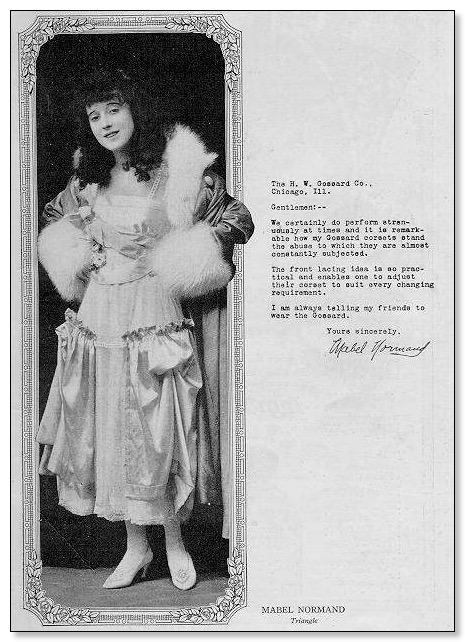
This advertisement originally appeared in September of 1916. (Mabel ad courtesy of Bruce Long.)
This advertisement originally appeared in September of 1916. (Mabel ad courtesy of Bruce Long.)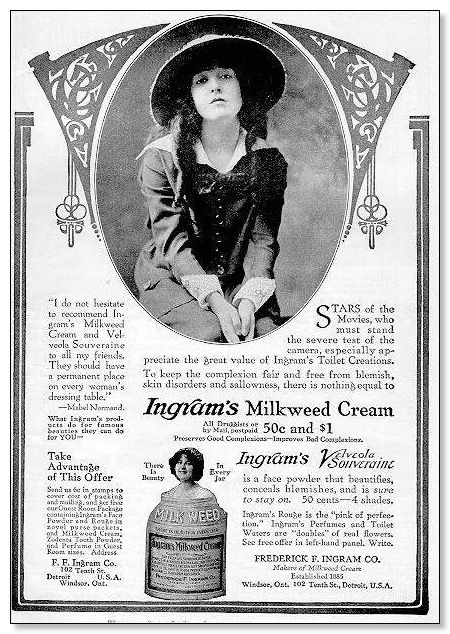
This advertisement originally appeared in October of 1916. (Mabel ad courtesy of Bruce Long.)
This advertisement originally appeared in August of 1918. (Mabel ad courtesy of Bruce Long.)
This advertisement originally appeared in June of 1919. (Mabel ad courtesy of Bruce Long.)
This advertisement originally appeared in July of 1919. (Mabel ad courtesy of Bruce Long.)
This advertisement originally appeared in October of 1919. (Mabel ad courtesy of Bruce Long.)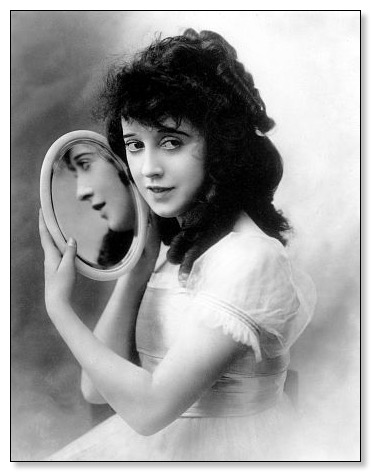
1918 publicity photo, Courtesy MPTV.net
This is actress Mabel Normand with Lee Dougherty, Jr. on the set of a Biograph film.
She was born on Nov. 16, 1894 and was slightly over 16 when she went to work for the Biograph Studio on East 14th Street in New York City.
Mabel was known as Muriel Fortescue in the early days of her acting career. She left Biograph for a short time to work for Vitagraph, but returned in the winter of 1911. Her star continued to rise at Biograph where she became an important star for the studio, working mostly under the direction of Mack Sennett.
Mabel left Biograph with Sennett when he formed Keystone in 1912. He was deeply in love with Mabel and described her "as beautiful as a spring morning." Wedding plans were made several times, but a marriage between the two was never to be.
Starring in several Chaplin films for Sennett, Mabel proved to be the most talented comedienne of the silent era. As her popularity rose, she began to press for more complex roles.
Sennett and his backers, Bauman and Kessel, formed the Mabel Normand Feature Film Company and produced Mickey. The film was not released until 1918 and in the meantime, the disappointed Mabel had signed a five-year contract with Goldwyn.
Without Sennett's guidance, Mabel became part of the social whirl of Hollywood. All-night parties and rumors of drug use began circulating as Mabel began showing up late for work - or disappearing for days at a time.
Mabel's career was dealt a crushing blow in 1922 with the mysterious death of director William Desmond Taylor. She was linked romantically with Taylor and was dragged into the case because she was the last person to see him alive. She was proved innocent, but the ghastly press coverage permanently ruined her image as a star.
Just as she was recovering from the Taylor scandal, her chauffeur was found, gun in hand, standing over the body of millionaire, Cortland Dines. Reportedly, the gun belonged to Mabel. Her popularity rapidly began a downward spiral. Her last feature was The Extra Girl in 1923.
She married Lew Cody, the villain in Mickey. Her happiness was doomed from the beginning as both she and Cody were suffering from terminal illnesses. Cody had a fatal heart condition and Mabel succumbed to tuberculosis and pneumonia. She died in 1930.
In 1974, she was portrayed in the Broadway musical, "Mack and Mabel" by Bernadette Peters.
Destin tragique que celui de Mabel Normand.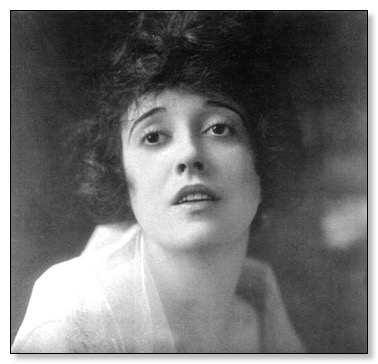
Née en 1892 à Staten Island (New York), Mabel Normand était d'une grande beauté ; elle savait également jouer la comédie, possédait un sens de l'humour merveilleux et, plutôt acrobatique, elle avait cette facilité de pouvoir recevoir autant de coups qu'elle pouvait en donner au cours de tournages souvent improvisés.
D'abord chez Vitagraph (de 1910 à 1912), elle fut dirigée quelque temps par D. W. Griffith puis suivit Mack Sennett à Hollywood.
De 1912 à 1916, elle tourna plus de 125 films pour la compagnie de Sennett, souvent ayant dans leur titre son propre nom : Mabel’s Bear Escape, Mabel Lost and Won, etc.
En 1915, elle était devenue la comédienne la plus connue dans l'industrie du cinéma mais comparativement à Mary Pickford ou Charles Chaplin, son salaire était une maigre pitance.
Quittant Sennett, elle passa chez Samuel Goldwyn, revint chez Sennett pour finalement obtenir le contrat qu'elle désirait auprès de Hal Roach.
De toutes les fêtes, menant une vie mouvementée, elle fut malheureusement mêlée aux deux grands scandales hollywoodiens des années vingt (Fatty Arbuckle, son compagnon dans de nombreux film, accusé de meurtre, et l'assassinat de William Desmond Taylor). Le tollé de protestations des ligues moralisantes qui suivit ces deux affaires détruisit sa popularité comme celles de plusieurs autres comédiens.
Elle tourna son dernier film en 1927 et mourut, alcoolique et de tuberculose, en 1932.
http://www.udenap.org/groupe_de_pages_08/normand_mabel.htm
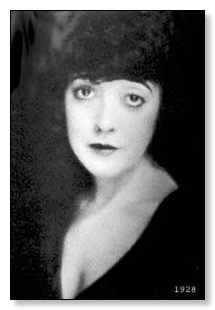
More on : http://fr.wikipedia.org/wiki/Mabel_Normand

Michael Fortescue (Music)
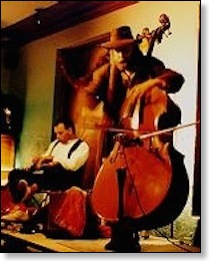 .
. 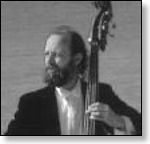

OzLit News – November 1996
November 23, 1996 – Carmel Bird informs us that on "November 27 at 7pm at Brunswick St Bookshop, Melbourne I will read from my new book AUTOMATIC TELLER and I will be accompanied as I read by Michael Fortesque on the double bass." Admission is free.
NORTH-WEST CENTRE CULTURAL PROGRAM
Arts Calendar 2000
Author Carmel Bird and musician Michael Fortescue team up to bring to life Carmel’s new children’s book The Cassowary’s Quiz - A magical journey in the Australian bush where two small dolls meet all kinds of bird life and find enchantment in the music of the King Superb Parrots.
Saturday 15th July 3pm
FREE ENTRY
University of Tasmania, North-West Centre
Jazz and Text
Renowned author Carmel Bird and Tasmanian musician Michael Fortescue (double bass) team up to surprise and delight the audience with a contemporary performance of literature and music.
Saturday 15th July 7pm
Cost $5 (no concession)
University of Tasmania, North-West Centre
Tasmania 2nd June, 1999
IMPROV AWARD - SEMI-FINALS
Direct broadcast from
the Tasmanian Conservatorium of Music,
Hobart, presented by John Crawford.
We had nearly 100 members in the audience,
squeezed into to Recital Hall.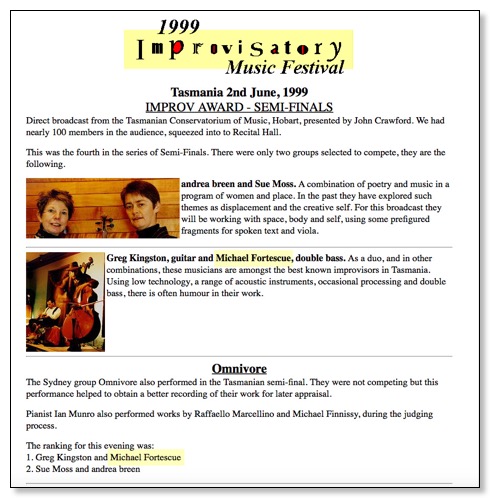
Greg Kingston, guitar and Michael Fortescue, double bass. As a duo, and in other combinations, these musicians are amongst the best known improvisors in Tasmania. Using low technology, a range of acoustic instruments, occasional processing and double bass, there is often humour in their work.
...
The ranking for this evening was:
1. Greg Kingston and Michael Fortescue
2. Sue Moss and andrea breen

Miss May Fortescue - 1876-1958
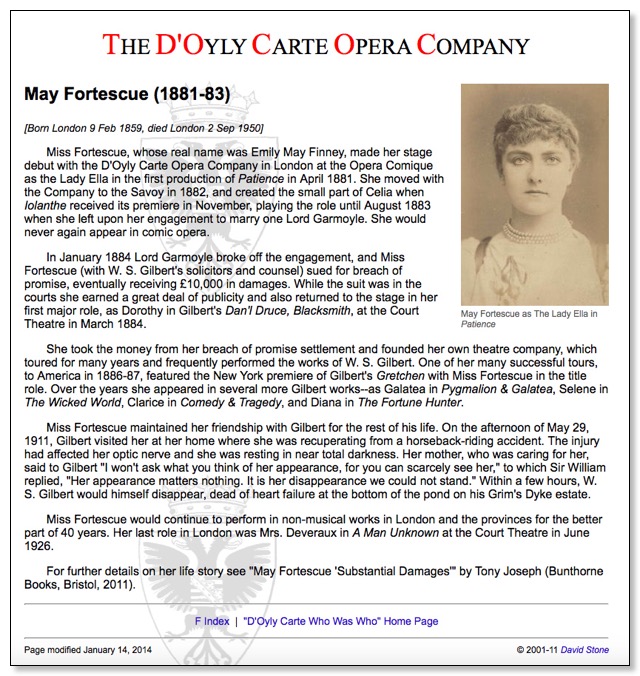
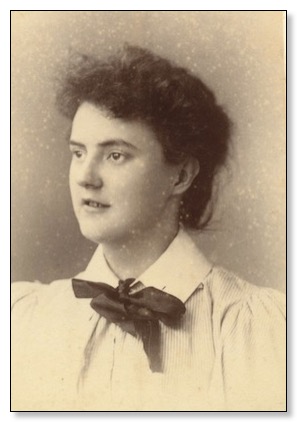
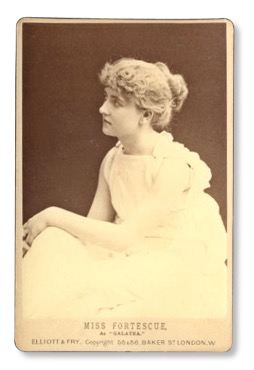
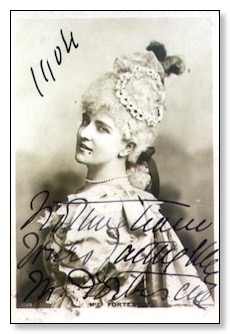 .
. 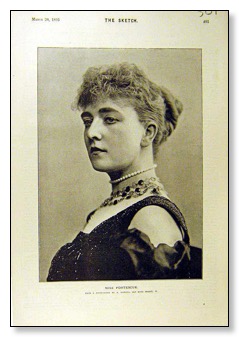
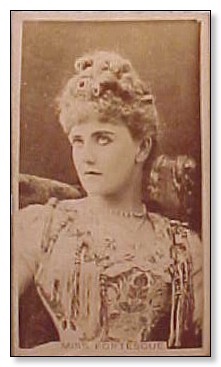 .
. 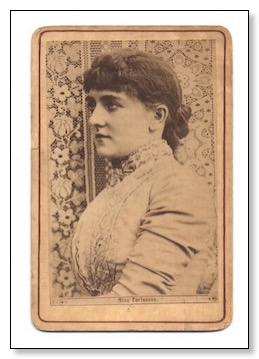 .
. 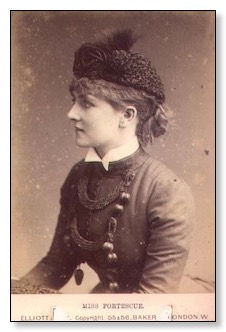
| THE D'OYLY CARTE OPERA COMPANY |
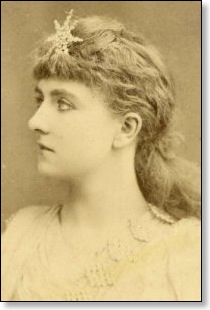
| May Fortescue |
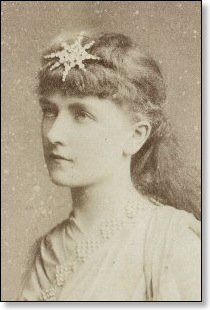
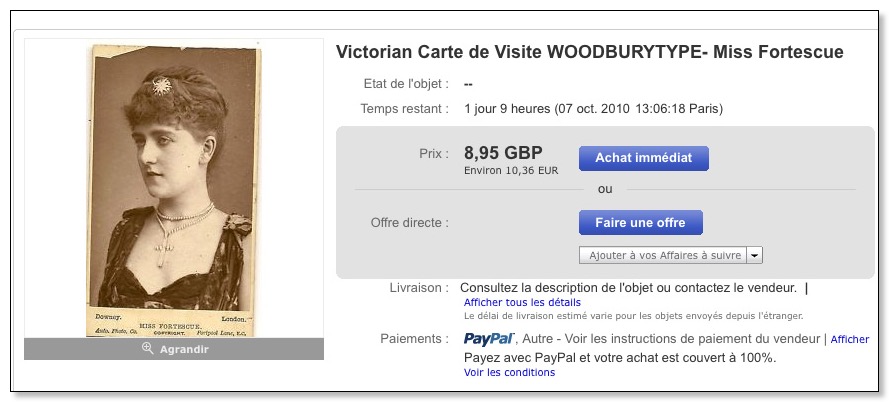
| 26th Antique and Collector Firearms, Art, Western and Indian Relics AUCTION |
05/07/1999 Fri
... |

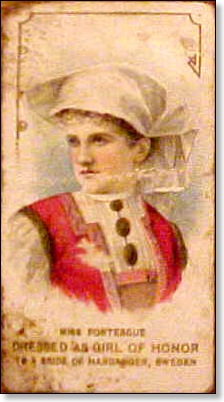

Mary Jane of canada Fortescue - 1878-1918
Michael D. Fortescue
Language Relations Across Bering Strait:
Reappraising the Archaeological & Linguistic Evidence
Fortescue, Michael D.

Miss Fortescue
E. Cobham Brewer 1810–1897.
Dictionary of Phrase and Fable. 1898.
Min’cio or Min’tio.
The birthplace of Virgil. The Clitumnus, a river of Umbria, was the residence of Propertius; the Anio is where Horace had a villa; the river Mels, in Ionia, is the supposed birthplace of Homer. Littleton refers to all these in his Monody on |

Marion T. Fortescue
![]()
Music for the Nation: American Sheet Music
Item 2 of 3
My darling have you money / by Marion T. Fortescue.
Fortescue, Marion T..
CREATED/PUBLISHED
Chicago: Chicago Music Co., 1881.
SUBJECTS
Songs with piano
RELATED TITLES
Music for a nation: American sheet music, 1870-1885.
MEDIUM
1 score
CALL NUMBER
M2.3.U6A44
PART OF
American 19th-century sheet music. Copyright deposits, 1870-1885
REPOSITORY
Library of Congress. Music Division.
DIGITAL ID
sm1881 13560 urn:hdl:loc.music/sm1881.13560 http://hdl.loc.gov/loc.music/sm1881.13560 ![]()
http://memory.loc.gov/cgi-bin/ampage?collId=mussm&fileName=sm/sm1881/13500/13560/mussm13560.db&recNum=0&itemLink=r?ammem/mussm:@OR(@field(AUTHOR+@3(Fortescue,+Marion+T+++))+@field(OTHER+@3(Fortescue,+Marion+T+++)))&linkText=0
http://memory.loc.gov/cgi-bin/ampage?collId=mussm&fileName=sm/sm1881/13500/13560/mussm13560.db&recNum=0&itemLink=r?ammem/mussm:@OR(@field(AUTHOR+@3(Fortescue,+Marion+T+++))+@field(OTHER+@3(Fortescue,+Marion+T+++)))&linkText=0





Marshall Fortescue (Music)
![]()
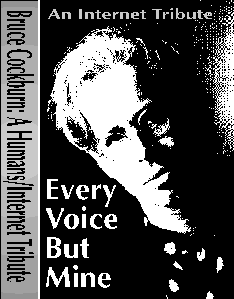
Every Voice But Mine
Every Voice But Mine was recorded by members of Humans, an Internet electronic mailing list that is dedicated to the discussion of Bruce Cockburn, his music - and his touring schedule! Humans was started in July, 1991 by Dan Farmer who continues to maintain it to this day. There are more than 200 members. If you have Internet access, you can subscribe to Humans by sending a request to "humans-request@bi.fish.com"
The musicians hail from various cities in Australia, Canada and the United States. The music was recorded because of a deep appreciation of the music of Bruce Cockburn that is shared by everyone who participated. The production and distribution of this tape was done on a not-for-profit basis.
The Contributors
- Marshall Fortescue; MSMAIL.FORTESCH@TSOD.lmig.com
- Steve Graham; sgraham@umich.edu
- Will Kaufman; freewill@u.washington.edu
- The Kind; 617-965-8548
- Peter Klausler; pmk%moliere@uunet.uu.net
- Rod Potter; rodp@yorku.ca
- Grant Shillabeer; c/o Arthur@cswamp.apana.org.au
- Chris Sullivan; ab791@freenet.carleton.ca
- Steve Watson; watson@sce.carleton.ca
- Charles Wolf; charles@phx.mcd.mot.com
Side One
- Intro/Foxglove -- Rod Potter
- If I Had A Rocket Launcher -- The Kind Brett Ginter, Bill Salkewicz, Jim Harris, Bob Hovanec, Derek Davies) Recorded live at State Street Bank, August 1992
- God Bless The Children -- Eyes Turn Skyward (Will Kaufman)
- One Day I Walk -- Steve Watson
- Outside A Broken Phone Booth With Money In My Hand -- Marshall Fortescue: guitar, Noel Carlson: lead vocal
- Salt Sun & Time -- Grant Shillabeer
- Waiting For A Miracle -- Steve Graham
- Mamma Just Wants To Barrelhouse All Night Long -- Rod Potter; Mitch Potter (lead guitar)
- Cry Of A Tiny Babe -- Charles Wolff
- Fall -- Peter Klausler on Chapman Stick
- When The Sun Goes Nova -- Steve Watson: vocals & guitar; Seanna Watson: vocals, synth (banjo) and recording engineer.
- Inner City Front -- Charles Wolff
- Creation Dream -- Chris Sullivan: guitar, Stannard chimes, backing vocal; Kathleen Johnson: lead vocal, backing vocal; Greg Geeves: Synthesizer, engineering, mix; Guitar tuning: DADGAD
- It Won't Be Long -- Steve Graham
Acknowledgments
A special note of thanks to Steve Graham who was the driving force behind this project. Steve kept the project alive by badgering the rest of us to send in our songs ;) and toiled countless hours to weave our tapes into "Every Voice But Mine." Thanks Steve!
The cover artwork was scanned from a photo taken by George Whiteside which appears on page 97 of the "Bruce Cockburn: All the Diamonds" songbook, a collection of Cockburn songs recorded between 1969 to 1979. Published by the Ottawa Folklore Center, "All the Diamonds" provides considerable insight into Cockburn's songwriting and guitar techniques. The transcriptions include both music and tablature. You can reach the OFC at the following address:
OFC Publications (A Division of the Ottawa Folklore Center Ltd.) P.O. Box 4061, Station E, Ottawa, Ontario, Canada K1S 5B1
Friends of the Earth
Taken from the liner notes of "Dart to the Heart" - because it's important...
"The ozone layer is being depleted. UV-B radiation is on the increase. The threat to our food supply, to animals, to our health, becomes more ominous by the minute. If this scares you as much as it does me, you might consider contacting Friends of the Earth. We are an international organization working hard on ozone protection, as well as other environmental issues. (I'm honourary chairperson of F0E Canada)" --Bruce Cockburn
Friends of the Earth Canada 251 Laurier Avenue West, Suite 201, Ottawa, Ontario K1P 5J6 Phone (613) 230-3352 or (800) 267-9607
Friends of the Earth (USA) 1025 Vermont Avenue N.W., 3rd Floor, Washington, D.C. 20005 Phone (202) 785-7400
Various Artists: Every Voice By Mine:
An Internet Tribute to the Music of Bruce Cockburn
Released: 1994?
Tune(s):
Intro/Foxglove - Rod Potter
If I Had a Rocket Launcher - The Kind
(Brett Ginter (sp?), Bill Salkewicz, Jim Harris, Bob Hovanec,
Derek Davies) Recorded live at State Street Bank, August 1992
God Bless the Children - Eyes Turn Skyward (Will Kaufman)
One Day I Walk - Steve Watson
Outside a Broken Phone Booth with Money in My Hand - Marshall
Fortescue, guitar; Noel Carlson, vocal
Salt, Sun and Time - Grant Shillabeer
Waiting for a Miracle - Steve Graham
Mama Just Wants to Barrelhouse All Night Long - Rod Potter
Cry of a Tiny Babe - Charles Wolff
Fall - Peter Klausler on Chapman Stick
When the Sun Goes Nova - Steve Watson: vocals & guitar;
Seanna Watson: vocals, synth (banjo) and recording engineer.
Inner City Front - Charles Wolff
Creation Dream - Chris Sullivan: guitar, Stannard chimes, backing
vocal; Kathleen Johnson: lead vocal, backing vocal; Greg
Geeves: Synthesizer
It Won't Be Long - Steve Graham
Note:
Every Voice But Mine was the brainchild of Rod Potter, and was assembled by Steve Graham. It is a "just for fun" production; everyone was encouraged to submit material. In spite of this, there are at least a few outstanding tracks (you decide which ones). For more information regarding this special tape, contact Steve Graham at:
Steve Graham
2277 S. Grove 823 W
Ypsilanti MI 48198-9291
Various Artists: Festival of Friends:
An Internet Tribute to the Music of Bruce Cockburn (Part 2)
Released: 1997
Tune(s):
Total Time: 68:00
Tie Me At the Crossroads -- Steve Graham
Great Big Love -- Charles Wolff
Bright Sky -- Chris Sullivan
Lily of the Midnight Sky -- Will Kaufman
Lord of the Starfields -- Charlie McDermott
Skylarking -- Murray Harrison
Waiting for a Miracle -- Inner Groove (Blair F.)
Burden of the Angel/Beast -- Marshall Fortescue/Noel Carlson
Night Visions (Flood of Tears) -- Dan Bullenkamp (Morok)
(Not a Bruce song, but Dan asked if we could include it anyway
and no one objected -- the Bruce influence shows.)
Broken Wheel -- Charles Wolff
Water Into Wine -- Murray Harrison
You Don't Have to Play the Horses -- Charlie McDermott
All the Diamonds -- Paul Leach
Understanding Nothing -- Will Kaufman
Dweller by a Dark Stream -- Blair Frodelius
Mama Just Wants to Barrelhouse All Night Long -- Pat Mrizek
Festival of Friends -- Charlie McDermott/The Wujekstock Minstrels
Note from Steve Graham:
Like it's predecessor, Every Voice But Mine, this was a 'Just for Fun,' anyone can play production. Some tracks are obviously better than others, but there's some good stuff.
Write to me the old fashioned way:
Steve Graham
2277 S. Grove 823 W
Ypsilanti MI 48198-9291
Mike Fortescue (Music)
DIE KRAFT DER SCHAMANAN / CD Wellness & Meditation NEU
Produktion: Mike Fortescue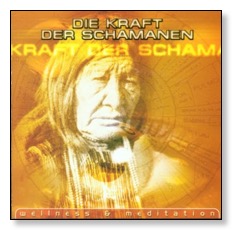 .
. 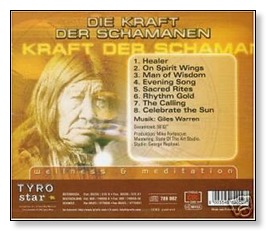
Die Kraft der Schamanen
Wellness & Meditation
Essentielle Musik zum Wohlfühlen
1. Healer
2. On Spirit Wings
3. Man of Wisdom
4. Evening song
5. Sacred Rites
6. Rhythm Gold
7. The Calling
8. Celebrate the Sun
Label: TYROstar
Produkt-Nr.: CD 789002
EAN CD: 9003549890027
Genre: Essentielle Musik zum Wohlfühlen
Gesamtzeit: 59.02 Min.
Produktion: Mike Fortescue
Mastering: State Of The Art Studio
Studio: George Raphael
Mortimer Fortescue (WC Fields Pseudonym)

| | ||
| | |
W.C.'S STORY
He was born William Claude Dukenfield on January 29, 1880 in Darby, a town just outside of Philadelphia, Pennsylvania. April 10, 1880 and February 9, 1879 have also been slated as his birthday, and although incorrect, Fields himself never bothered to set the record straight. Why should he? The extra "natal days" provided him with two more opportunities to receive celebratory gifts of assorted beverages. Multiple birthdays would be just a sample of the many myths and legends surrounding "The Great Man," W.C. Fields. But once you sweep the tall tales away, what remains is incredible: he succeeded in seven separate careers that demanded seven separate talents.
Ah yes, the tale tales! As W.C. Fields' grandson, author, producer, and film historian Ronald J. Fields, jokingly notes, "The most difficult part of researching W.C. Fields' life was to separate fact from fiction. Not only did many Hollywood writers build legends around him, but W.C. was the biggest legend producer of all of them." Or as W.C. Fields himself said, "Why tell the truth, when with a little embellishment you can bring fun and laughter to interviews." Film publicists found him to be a dream to work with, because unlike other stars, he didn't care what the Publicity Department wrote about him, just as long as it was in keeping with his mythic image. Fields himself engineered the publicity when he admitted to a reporter, "I wanted to be a definite personality."
The oldest of five children, he was born in a hotel room appropriately situated just above the bar that his father managed. His parents were James and Kate (Felton) Dukenfield. His father immigrated from England at the age of 13 and talked with a pronounced midlands accent (which was a source of amusement to James' wife, Kate, and their young son, both of whom imitated James' accent for laughs). After the birth of their son, Kate insisted that James quit managing the bar (and quit drinking as well) in order to provide a more appropriate atmosphere in which to raise children. James obeyed his wife and became a huckster selling fruits and vegetables from a cart he pulled through the streets of Philadelphia.
...

PSEUDONYMS
Fields invented many funny names, both for his characters and for his own screenwriting credits:
Maharajah of Bingo
Algernon Biggleswade
Professor Quail
Ophelia Snapdrop
Sir Marmaduke Gump
Og Oggilby
Folger E. Bidwell
Abigail Twirlbaffing
Dorothea Fizzdockle
Charles Bogle
J. Pinkerton Snoopington
Aristotle Hoop
Mahatma Kane Jeeves
Senor Guillermo McKinley
Sneed Hearn
High-Card Harrington
Carl La Fong
Cholmondley Frampton-Blyte 9
Marc Antony McGonigle
J. Frothingham Waterbury
Larson E. Whipsnade
Rheba Goldberg
Bartley Neuville
Figley E. Whitesides
Anastasia Bel-Goodie
Claude Bissinet
Dr. Otis Guelpe
Lita Labetty
Otis Criblecoblis
Chief Big Spear
Bronislaw Gimp
Gus Winterbottom
Little Small Blanket
Ouliotta Hemoglobin
Ambrose Woolfinger
Wilkes Heap
Filthy McNasty
Eustace McGargle
Oooleota Dillwig
Officer Postlewhistle
Hermisilio Brunch
Elmer Bimbo
Cornelius O'Hare
Oglethorpe P. Bushmaster
Colonel Roscoe Slemp
Cozy Cochran
Chester Snavely
Sapadola Sidley-Deasey
Cleopatra Pepperday
A. Pismo Clam
Oliotha Shugg
Countess de Pouisse
Sir Mortimer Fortescue
Olga Limbo
Egbert Souse
Agatha Sprague
Fuller Ginnis
Cuthbert J. Twillie
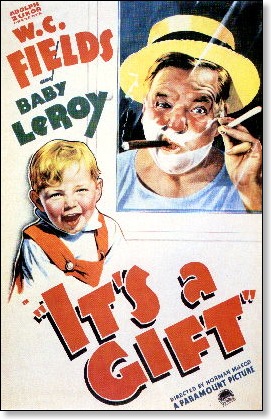
A W.C. Fields Roster | ||
